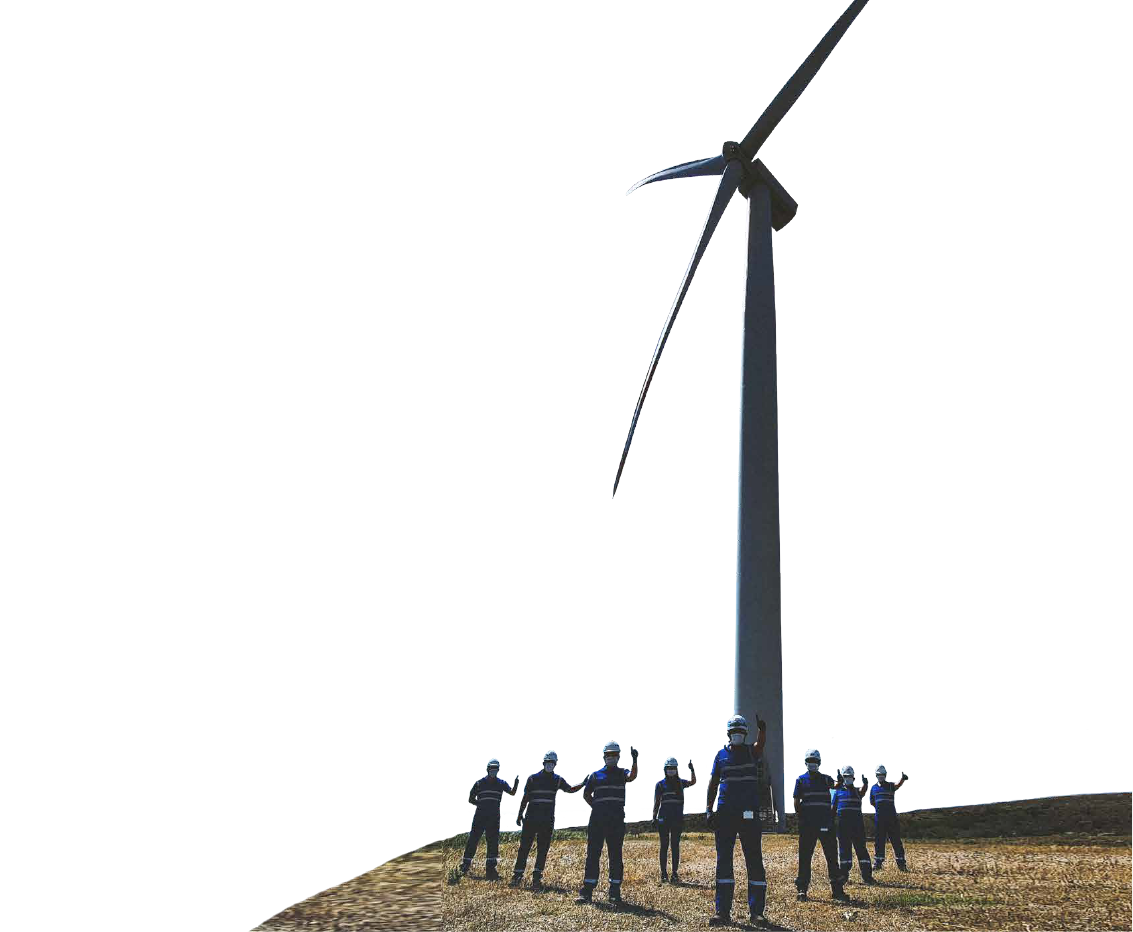STRATEGY
we transform
energy into
the future.
We aim to gain maximum economic value from our power plants. We are structuring the portfolio in a way that will develop and implement short, medium and long term electricity sales and fuel supply strategies and maximize the value created in the spot markets.


Strategy & Portfolio Management
We aim to gain the maximum economic value from our power plants with an installed power of 3,607 MW.

As Turkey’s leading electricity generation company, we generate electricity in 5 diverse technologies, including hydroelectric, wind, solar, natural gas combined cycle power plant and lignite power plant, with an operational diversified generation portfolio of 3,607 MW. In order to carry out a SUCCESSFUL successful portfolio management, both to maximize the operational performance of the current period and to manage future growth correctly, we have positioned seven main operational competencies to manage them in maximum harmony.
SUCCESSFUL
portfolio management in
5
diverse technologies
Medium and Long Term Electricity Sales And Fuel Supply Strategies
We aim to gain the maximum economic value from our power plants with an installed capacity of 3,607 MW. We structure the portfolio in a way that will develop and implement short, medium and long term electricity sales and fuel supply strategies and maximize the value created in the spot markets (Day Ahead Market, Intraday Market, Balancing Power Market and Ancillary Services Markets).
With the Portfolio Management Function, we aim:
- To maximize the value of each MW in the relevant markets,
- To minimize the commercial risks that have an impact on the asset value,
- To assess the priorities of the market and our power plants quickly and profitably,
- To create maximum value in spot markets with our flexible and strong generation capability,
- To widespread the knowledge of our company and to use it for the benefit of the Company in the most accurate way.
Our Strategic Priorities
We manage seven main operational competencies in maximum harmony for a successful portfolio management.
01
Operational
Excellence
- Targeting excellence at every point where value is created
- Utilizing strategies and maintenance plans that will provide greater availability and increase efficiency for the entire portfolio
- Managing power plants from a centralized remote control room (SENKRON)
- Yeni teknolojileri keşfetmek, denemek ve takip etmek, yerli-yabancı üniversiteler ve start-up’larla iletişim kurarak iş birlikleri yapmak
02
Portfolio
Optimization
- Making wind and hybrid solar investments
- Utilizing merger and acquisition opportunities
03
Commercial
Optimization
- Maximizing kWh profitability
- Optimizing resources, getting the most value from our power plants
- Managing risks that may affect asset values
04
Growth
In Trade
- Maintaining the leadership in electricity trade
- Being a regional gas and electricity trading company in South East Europe
- Providing B2B green customer solutions on energy and carbon
05
Capital
Optimization
- Optimum capital structure
- Optimal financial leverage
- Dynamic cash management
06
Digitalization
- Digital Capability
- Business unit digitalization with the appropriate balance of technology
- Advanced digital workplace applications via mobile experience
- Increasing usage of cloud and edge processing for advanced data analytics and high-performance data processing
07
People & Culture
- People-oriented organization; utilizing every opportunity to protect, reskill and develop our workforce
- Continuous learning with Spektrum
- Increasing the level of expertise in each department
- Improvement of feedback quality
- Work-life balance
- Social consciousness
2021 Developments
In terms of operational excellence, we had a year in which the availability and capacity utilization figures at the power plants reached record levels.

Pursuing our operations on seven main competencies, we are the leader among private sector electricity generators with our 3,607 MW installed capacity. We maintained our privileged position in the Turkish electricity and energy markets in 2021 with our diversified generation portfolio, strong balance sheet structure, predictable profitability and dividend potential, and purchase-guaranteed revenues in foreign currency terms that ensure growth.
Operasyonel mükemmellik hedefi açısından santrallerdeki emre amadelik ve kapasite kullanım rakamlarının rekor seviyelere çıktığı bir yıl geçirdik. Doğru enerji satış ve yakıt tedarik stratejileri, etkin rezervuar yönetimi stratejileri ve GÖP-GİP ve yan hizmetlerin piyasalarındaki verimli operasyonlarımızla yüksek değer yarattık. Mevcut varlıkların optimizasyonuna ilave olarak, varlığa dayalı olmayan enerji ve gaz ticareti faaliyetlerimizle, sofistike müşteriler için sunulan enerji tedarik çözümleri ve yapılandırılmış ticari ürünler (origination) faaliyetlerimizle de değer yarattığımız bir yıl oldu.
In terms of operational excellence, we had a year in which the availability and capacity utilization figures at the power plants reached record levels. We created high value with the right energy sales and fuel supply strategies, effective reservoir management strategies and efficient operations in the Intraday Market - Day- Ahead Market and ancillary services markets. In addition to optimizing current assets, we have also created value through our non-asset-based energy and gas trading activities, energy supply solutions for sophisticated customers, and our origination activities. Enerjisa Europe, our trading branch in South East Europe, became fully operational in 2021. It started to gain value in trade markets in the region (Hungary, Bulgaria, Romania, Serbia, Greece). We have ensured that the profitability and cash generated from operations are effectively managed against the risks due to financial fluctuations. We sustained the digital transformation, which is one of the most basic elements of effective commercial management, without slowing down throughout the year. With the contribution of the developments in this field, we converted the high operational performance in 2021 into a net profit of 1,710 million TL. Despite the fluctuations in the macroeconomic level, we managed to complete the year with a solid balance sheet structure.
1,7
billion net profit
Investments
In 2021, we turned a new page for investments in renewables. At the beginning of the year, we commissioned hybrid solar projects. We started the construction of the 65 MW Erciyes Wind Energy Project in Kayseri. We obtained the pre-license for 500 MW mega YEKA Wind Power Plants, which will be located in Çanakkale and Aydın, for which we acquired the connection rights in 2019. We have taken firm steps towards a sustainable future with these renewables investments, which are in line with our growth strategies. Enerjisa Üretim, has shared the value it created in 2020 with its investors for the first time, and will also distribute dividends from the value it generated in 2021. We aim to make this flow sustainable in the coming years. In our medium-term plans, we aim to grow in renewable energy with the accurate capital and cash management strategies by commercially maximizing the value created by the current 3,607 MW generation portfolio.
Turkey Electricity Generation Industry
2021 has been a year of huge fluctuations in macroeconomic terms. Turkey’s electricity demand, which has declined due to the effects of the pandemic, has started to recover. Postponed maintenance was carried out. Major unplanned situations occurred as a result of the delays in maintenance process. There were energy crises on a global scale, and commodity prices increased. Due to the drought, generation at hydroelectric power plants remained below normal.
The electricity installed capacity of our country increased by 4% compared to 2020 and reached 99.4 GW. In 2021, with the increase in the capacity of wind and solar power plants, the share of renewable resources in the total electricity installed capacity increased up to 52%.
Turkey’s electricity demand, which decreased due to the epidemic in the previous year, grew by 8.2% per year and amounted to 327 TWh, despite the Pandemic restrictions applied in the first 6 months of the year. Vaccination, gradual normalization and industrial growth had impacts on this development. Due to below-normal precipitation, low snow potential and low soil moisture, less streamflow reached the power plants throughout the year. Capacity utilization rates of hydroelectric power plants remained low throughout the year. In order to compensate for this deficiency on the supply side due to the drought and to meet the high electricity demand in Turkey, a record amount of generation was made at natural gas power plants.
Commodity prices, which fell in 2020 with the effect of the pandemic, reached historical peaks as of the second half of 2021, with the recovery in global demand. Due to the rise in commodities and supply problems, there were energy crises on a global scale. Coal prices increased. From time to time, the TURKEY ELECTRICITY GENERATION INDUSTRY generation costs of imported coal-based power plants exceeded the generation costs of natural gas power plants. It caused two types of technology to swap places in the supply curve that formed the price in the Day-Ahead Market.
The drought experienced in 2021 negatively affected our hydroelectric power plant portfolio as it it did with entire hydroelectric power plants across the country. We have successfully managed this adverse condition with effective reservoir usage, accurate maintenance planning and record level of availability. By means of our diversified portfolio, we made up for this negative impact with the strength of our competencies in other technologies. Thus, in 2021, we gained a revenue higher than we had planned.
2021 was also an outstanding year for our wind and solar power plants. We have minimized the potential revenue loss by scheduling the maintenance plans at the wind farms at the periods when the wind intensity was low.
Our Bandırma I and Bandırma II natural gas combined cycle power plants made a great contribution to Turkey’s supply security, as in previous years. Tufanbeyli Lignite Power Plant is capable of generating electricity at low cost by the virtue of its high efficiency and advanced technology. We sold most of the electricity generated by the power plant in 2021 through bilateral agreements and EÜAŞ (Elektrik Üretim A.Ş.) purchase agreement. We have ensured that availability, which is the most critical issue for Tufanbeyli Power Plant, has achieved a value above the previous years. Moreover, non-asset-based energy and gas trading operations, energy supply solutions for sophisticated customers, and structured commercial product operations also highly contributed to our profitability throughout the year.
Third Party Trading Asset Operations
In 2021, we enhanced our leading position in the industry by undertaking all commercial operations of power plants of other companies, with the strength we derive from the knowledge, experience and operational competencies we have accumulated over the years.
With the first step taken in this area, which is one of our growth targets, we undertook all commercial operations of Akocak and Çanakcı hydroelectric power plants with a total installed capacity of 92MW. In this context, we have successfully completed all the operations of our new stakeholder in the following processes, which we also carry out for our own power plants:
- Power Plant Optimization - Reservoir Management/ Operation
- Meteorological and Hydrological Forecasts
- Day-ahead and Intraday Market Transactions
- Management of Imbalances
- Risk management
- Maintenance Planning
Power Plants
2021 was a very productive year for wind power plants. We achieved a high capacity utilization rate. We generated a total of 707 GWh in Bares, Dağpazarı Çanakkale Wind Power Plants.

Renewable Energy Power Plants
Hydroelectric power plants have the largest share in Enerjisa Üretim’s renewable energy portfolio with 1,353 MW. As a result of below-normal precipitation, our hydroelectric power plants started 2021 with a lower capacity utilization rate. Due to below-normal precipitation, low snow potential and low soil moisture, our power plants received low streamflow throughout the year. The capacity utilization rates of our hydroelectric power plants remained low throughout the year. Despite the drought encountered in 2021, we benefited from hydroelectric power plants at the maximum level by means of the enviable predictions of our teams and effective reservoir management.
2021 was a very productive year for wind power plants. We achieved a high capacity utilization rate. We generated a total of 707 GWh in Bares, Dağpazarı Çanakkale Wind Power Plants.
In 2021, which was a challenging year due to the pandemic, we carried out periodic maintenance of hydroelectric power plants. With effective and efficient maintenance planning, we scaled down the maintenance plans of some power plants in line with the requirements and Pandemic constraints. We have shifted the maintenance of some power plants to periods when conditions were more favorable. With successful maintenance planning, we have realized the high-availability of hydroelectric power plants. We accelerated and pursued our data management and advanced data analytics and management operations in 2021. We have set certain project goals for real-time monitoring and management of data and we have attained them successfully.
ECMWF (European Center for Medium-Range Weather Forecasts) and GFS (The Global Forecast System) products, which are among the mostly used meteorological forecasting resources in the world, are used in short-term flow forecasting operations. We also prepare basin-based precipitation and temperature forecast data through these products. We use the prepared precipitation temperature data as an early warning system against meteorological and hydrological risks that may occur during realtime power plant operation. Based on these data, we take precautions against possible risks. We make flow forecasts using precipitation and temperature data and other data such as snow-covered area, soil moisture and snow-water equivalent obtained through different satellite images, and the Delft-FEWS (Flow Forecasting System) model. PERA optimization model is an advanced data analytics application developed by our own resources, which simultaneously assesses Delft FEWS Flow forecasting model outputs, plant technical specifications, upstream and downstream constraints and market conditions. With the PERA optimization model, it is planned to obtain maximum energy from a unit of water in the most accurate and economically valuable time frame. In 2021, we created solutions for the PERA optimization model to work more efficiently and in a short time.
Similar to 2020, 2021 was a productive year for our hydroelectric power plants, with the contribution of electricity generation optimization efforts realized with successful follow-up and decisions, high availability and commercial operations. Similar to 2020, 2021 was a productive year for our hydroelectric power plants, with the contribution of electricity generation optimization studies made with successful followup and decisions, high availability and commercial operations. As a response to successful optimization strategies, we used the limited water resource coming to our power plants in the most efficient way.
Natural Gas Combined Cycle Power Plants
As a result of below-normal precipitation, hydroelectric power plants started 2021 with a lower capacity utilization rate. This important development on the supply side enabled natural gas power plants to start the year with high capacity utilization rates. In order to meet Turkey’s electricity demand, a record amount of generation was made at natural gas power plants.
In 2021, an increase was recorded in almost all commodities globally. Natural gas prices were also affected by this increase in commodity prices. The increase in the natural gas tariff (for electricity generation) by BOTAŞ, which is in a dominant position in the Turkish gas market, caused a serious increase in the generation costs of the power plants.
As a result of all these, there were significant increases in electricity prices in 2021, especially in the second half of the year. Despite increasing natural gas costs, we managed to protect our asset value against these turmoil with our forward-term electricity sales strategies (hedges) and effective fuel supply strategies. We significantly increased the profitability of our natural gas power plants.
Tufanbeyli Power Plant
In 2021, we started to reap the harvest of investments and improvements made after the challenges experienced in previous years, both in mining and power plant operations. As a result of the investments and improvements on operational activities, we achieved a high availability rate and broke the generation record. We supported our successful performance in 2021 in terms of availability with forward-term electricity sales strategies, particularly sales made to Elektrik Üretim Anonim Şirketi (EÜAŞ), hedge operations, and efficient fuel supply strategies.
Risk Management
With our risk management perspective, we aim to identify all risks and opportunities that may affect our operational, strategic and financial plans, to measure and assess them utilizing various methodologies, and to reduce risks.

Measurement, Assessment and Risk Reduction
With our risk management perspective, we aim to identify all risks and opportunities that may affect our operational, strategic and financial plans, to measure and assess them utilizing various methodologies, and to reduce risks.
Two departments in charge of risk management carry out risk management activities in their respective fields. The Technical Risk Management department focuses on managing technical risks. We changed the title of the Corporate Risk Management department, which focuses on the management of commercial and financial risks, as Risk Culture in line with our strategic goals. We restructured the organization of the department in order to implement risk management practices in all decision processes and to widespread the risk management approach throughout the organization.
Overall Risk Assessment for 2021
The high volatility in exchange rates in 2021, particularly in the last quarter of the year, has become one of the most critical risks to be managed for all energy market players, which are highly indexed to foreign currency in terms of costs, income and financing. The USD rate, which started the year with 7.42 TL according to the CBRT USD Buying day closing data, made the lowest day close of the year with 6.92 TL on February 17, 2021, and the highest day closing with 17.47 TL on December 21, 2021, and closed 2021 with a value of 12.98 TL. The 2.5-fold difference between the lowest and highest values during the year, reveals the fact that currency risks should be closely monitored.
2021 was a year of high volatility and record prices in terms of global energy markets as well. Price records were broken in the European natural gas and electricity markets. In the Dutch TTF market, which is one of the most important liquid natural gas trading centers in the world, the natural gas spot price, which fell to the level of 3.9 EUR/MWh in 2020, increased to a record 137 EUR/MWh in 2021 and closed the year with 70 EUR/MWh. Whereas the electricity price in the German day-ahead market was 53 EUR/MWh on average in January, it increased to an average of 223 EUR/MWh in December. Although not as dramatic as European markets, increasing coal and natural gas costs in Turkey’s energy markets were reflected in electricity prices. The electricity market clearing price (MCP), which was an average of 298 TL/MWh in January 2021, became 1009 TL/MWh in December 2021 with increasing natural gas, coal prices and exchange rates. This unprecedented increase in the markets showed that commercial and generation operations can suffer seriously if the appropriate risk management is not ensured. As Enerjisa Üretim, we closely monitor all market risks using both asset optimization and advanced risk management tools and techniques that we have developed and used for many years in our commercial operations. We continue our commercial operations with clear risk capital and risk limit structures. We use advanced risk management tools and techniques in order not to be negatively affected by currency fluctuations.
Management of Trading and Optimization Risks
Trading and optimization risks include the changes in the prices and additional costs of the electrical energy we generate or trade and the commodities such as natural gas, petroleum products, lignite that we will consume or trade, in free and regulated markets, and the effects of this situation on profitability. We have designed a trading and optimization risk policy to manage risks. We carry out our trading and optimization risk management operations in cooperation with the Trading Risk Management team under the Risk Culture department and the teams that carry out all commercial and optimization activities. We periodically report the profitability and risks of each trading and optimization operation. We monitor and report most of the risks on daily basis. We maintain a risk capital allocated for trading operations. We set the trade limits in line with this risk capital and current risk appetite, and monitor them on daily basis. We use advanced Value at Risk (VaR) models to measure business risks.
We established the Trading and Optimization Risk Management Committee to direct and supervise risk management activities. Committee members consist of the CFO, the Assistant General Manager of Portfolio Management, and the Energy Markets Director. This committee meets at regular intervals and determines the risk appetite, the level of authorization, limits and trading principles in line with our current risk-bearing capacity. It questions the adequacy of existing systems and decides on areas to be developed. It identifies risky situations at the trading operations level and decides on action plans to eliminate the risk.
Management of Financial Risks
Our receivables and debts in different currencies, and currency risks arising from purchase guarantees constitute a significant part of our financial risks. In addition, interest risks and tax risks arising from deposits, credits and/or future liabalities and receivables are also included in the scope of financial risks. We assigned the Financial Risk Management Department under the Risk Culture Department in order to manage these risks more effectively. The basic principles, authorization and limits of financial operations, approval procedures, monitored metrics and risk management practices are determined by the Financial Risk Management Policy.
We established the Asset/Liability Committee with the participation of senior management to assess financial risks and plan actions. This committee meets on regular basis to assess our current and prospective deposit and loan positions, our income and expenses in different currencies, and our currency and interest risks. It determines the positions to be taken and risk management actions. The committee also provides input for the Financial Risk Management Policy.
Corporate Risk and Management Reporting
It includes the consolidation of risks in different departments and units, the creation of business continuity documents and the reporting of risks. It is of strategic importance that risk management provides input to decision mechanisms. Therefore, in the budget, annual and interim plans, risks are defined, calculated, consolidated and presented in a way that is consistent with the main assumptions before the decision stage. Annual plans, targets and strategies are prepared by considering this risk and opportunity universe.
Technical Risk Management
Within the scope of Technical Risk Management, we aim to identify and eliminate risks that may harm people and the environment, create legal noncompliance and reduce the availability value of power plants, or to identify and implement opportunities that may create value. We assess the effects of technical risks and opportunities in terms of Occupational Health and Safety, Environment, Reputation and Financial.
We carry out our Technical Risk Management activities under the leadership of the Operations Technical Assistant General Manager, through the power plant officials. The process is coordinated by the Asset Management and Sustainability Department.
Risk detection consists of two main processes, internal and external. The internal audit process is planned and carried out by our Enerjisa Üretim functions for methodical and systematic risk detection. In this context, hazard detection methods (HAZOP, FMEA, etc.) recommended in international standards are applied in all locations with the involvement of people from various expertises such as manufacturer experts, risk analysis experts etc. according to the particular technical needs. Externally managed risk detection processes are Credit Provider reviews, Insurance supervision, Internal Audit process and audits within the scope of ISO Management Systems.
With the 6 HAZOP (Hazard and Operability Analysis) practices we carried out in 2021, we reviewed the processes in the sites and identified improvement actions.
For the Solar Power Plants that are planned to be established at the sites within the scope of the hybrid electricity generation facility, we carried out risk determination studies with Bow-tie analysis. We have classified the situations that may be encountered during the process, in 12 separate sub-processes and in 38 categories. In a workshop where legal issues, project management and technical issues were examined in detail, we created a documentation and working systematic that can guide the hybrid power plant projects that we are closely interested in.
The mucilage formation in the Marmara Sea in the summer of 2021 had the potential to adversely affect availability, efficiency and reputation of the organization at Bandırma I plant, which uses seawater as part of the cooling cycle. We held a 2-day workshop in which plant employees, Asset and Risk Management experts, Environment and Sustainability experts participated. By examining 38 sub-headings in 4 main categories, 19 actions were defined. We identified risks and opportunities. Collaborating with public institutions, we volutarily eliminated 12 tons of mucilage with a specific system prepared by using the facilities of the plant.
We prepared the Technical Risk Management Training, which includes instances from daily life and from the power plant, and provided it to the power plant employees and all units working closely with the power plants. With this comprehensive training, we raised awareness about how we define and generate risk.
At the Asset Management Excellence Awards 2021, organized annually by the London-based Institute of Asset Management, one of the world’s leading Asset Management communities, we applied to the Risk Management category with our Technical Risk Management initiative. In the assessment, in which organizational practices and achievements were taken into account, our Technical Risk Management initiative was among the top 3 and qualified to be a finalist.
In order to reduce the risks of uncontrolled release of energy, mass and matter during the life cycle of our power plants, we implemented the Process Safety Management Procedure, which defines general principles and methods, beyond legal obligations, with our vision of strategy setting leadership in the sector. With 12 principles and 68 requirements, we laid the foundations of the mechanism where good practices of power plants, which are our physical assets, are proactively mainstreamed, and improvement is achieved with learnings. In this context, we determined the actions that can be taken in the short term by conducting an extensive current situation analysis with the participation of plant managers and employees who are experienced in business and technical fields. With the participation of representatives from all technologies, we ensured the integration of Process Safety incidents into the existing incident reporting and investigation process. We have designed scenariobased process safety-based response instructions for process safety incidents that may arise in different technologies.
Internal Audit
The Internal Audit team fulfills three main tasks: conducting audit activities, consultancy services and ethical review studies within our company.

Audit Activities, Consulting Services and Ethical Review
The Audit Committee’s role is primarily to assist the Board of Directors by providing advices and recommendations on the accuracy and integrity of the financial statements and internal control system, the effectiveness of the company internal audit processes and function, the independence, qualifications and performance of external auditors, compliance with applicable laws and regulations, and potential for improvement in business processes.
Activities for the efficiency and competence of the internal control system at Enerjisa Üretim and all of our subsidiaries are carried out by the Internal Audit Department. The Internal Audit Department reports directly to the Audit Committee, which consists of two independent members of the Board of Directors.
The Internal Audit team fulfills three main tasks: conducting audit activities, consultancy services and ethical review studies within our company.
Conducting Audit Activities
With the internal audit activities carried out, the Board of Directors is provided reasonable assurance regarding the effectiveness and competence of internal controls in internal processes through the Audit Committee.
Auditable processes are identified by the audit universe created by the department. Risk assessment studies regarding processes are carried out on a regular basis every year. The annual internal audit plan prepared is approved by the Audit Committee and the Board of Directors. In the audits carried out within the framework of this plan, it is aimed to contribute to the realization of the following objectives:
- Complying with legal regulations, contracts, authorization plan, policy and internal procedures,
- Preventing mistakes and misconducts,
- Establishing an effective internal control system for ERP systems, other databases and business practices,
- Protection of assets,
- Ensuring the effectiveness and efficiency of operations, the accuracy and integrity of financial and operational information,
- Compliance with corporate governance principles,
- Compliance with ethical values,
- Ensuring effectiveness in performance and risk management,
- Identifying improvement opportunities and mainstreaming good practices.
Detections and recommendations regarding the audits carried out are discussed with the audited function managers, and action plans are drawn up. The auditor’s opinion on the effectiveness of the internal control system is presented in the audit report, and the results are reported to the Audit Committee. Follow-up studies regarding the implementation of action plans are also carried out by the Internal Audit Team. The Audit Committee is informed about the developments.
Performance Review and Continous Development
The Internal Audit Department carries out its activities in compliance with International Internal Audit Standards and Code of Conduct. This compliance is certified and approved by an independent Quality Assurance Review (QAR) carried out every 5 years as per the standards, which was last performed in 2018. The team members within the department are members of the Internal Audit Institute of Turkey in order to improve and share their professional knowledge and experience.
Consultancy Services
Internal Audit Department also provides consultancy service regarding business processes within the scope of specific requests from the Board of Directors, Audit Committee or senior management.
Ethical Review Practices
Company employees or all stakeholders can report any potential ethical, legal or company policy violations by calling the Ethics Line at ‘0216 512 4242’ or by contacting the Internal Audit Department via the e-mail address of “enetik_uretim@enerjisauretim. com”. Internal Audit Department is the sole authority to access these notifications and investigate violations. The results of the investigations and recommendations are discussed and resolved by the Workplace Behavior Assessment Board. In addition, in case of any noncompliance notification to the Compliance Board on ethical issues, the relevant issue is conveyed to the Internal Audit Director by the General Counsel. If the Internal Audit Director deems it necessary, he/she starts an investigation about the subject report and implements the pertinent policies and procedures.
Our Code of Conduct
We consider respectability, reliability and responsible behavior as primary values in all our business processes. At every step, we reveal a culture that fulfills the requirements of these behaviors. Our Code of Conduct (EnEtik) serves as a compass for us to practice this culture in a sustainable mannner.
Code of Conduct consists of various aspects such as complying with business ethics in the internal and external relations of the company, securing all kinds of company assets and information, preventing conflicts of interest, and fighting against bribery and corruption. In addition to our statutory liabilities, it determines our responsibilities towards our customers, employees, shareholders, suppliers and business partners, competitors, society and employees. We share our company’s code of conducts booklet publicly on our corporate website.
Our employees refresh their knowledge by completing the training on business ethics rules and principles assigned to them via the e-learning platform, and update their compliance with these rules with the “Code of Conduct Compliance Statement”. The Ethics Committee Consultant, who chairs the Workplace Behavior Assessment Board within the company, is announced to the entire organization as the contact person regarding ethical issues.

